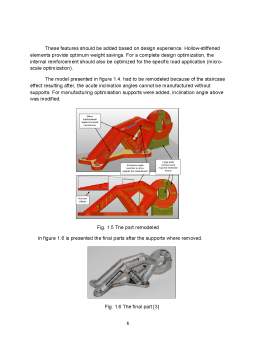Cuprins
- I. Introduction 3
- II. The equipment 7
- III. Working principle of SLM / DMLS 9
- IV. Parameters influence on SLM process 11
- V. Process Efficiency : SLM vs EBM Comparison 13
- VI. Conclusions 16
- VII. Bibliography 17
Extras din proiect
I. Introduction
In the rapid prototyping technology there are 2 possibilities of obtaining metallic parts based on the 3D models generated by CAD/CAM software using thermic energy generated by a laser focused on a plane surface of metallic powder layer:
1. SLS technology (selective laser sintering) / DMLS technology (direct metal selective laser sintering)
2. SLM technology (selective laser melting)
3. Currently, SLM is used to manufacture func-
4. tional prototypes and to build up final parts
5. directly. In this case the field of commercial
6. applications is limited to single parts or parts
7. in small batches.
8. Currently, SLM is used to manufacture func-
9. tional prototypes and to build up final parts
10. directly. In this case the field of commercial
11. applications is limited to single parts or parts
12. in small batches.
Currently, SLM is used to manufacture func-
tional prototypes and to build up final parts
directly. In this case the field of commercial
applications is limited to single parts or parts
in small batches.
Currently, SLM is used to manufacture functional prototypes and to build up final parts directly. In this case the field of commercial applications is limited to single parts or parts in small batches.
This paper proposes the manufacturing of the parts presented in the image below using the SLM process. The production volume is 20 pcs.
Fig. 1.1
The tool- and mold-making industry is a typical example of a branch producing final parts in small batches of approximately one to eight. Because of the almost infinite geo- metrical freedom, SLM is applied to manufacture tooling inserts containing conformal cooling channels. Thanks to SLM, an improved tool cooling can be attained, resulting in reduced cycle times and improved part quality. As a result the rapid manufacturing method SLM offers massive cost savings in combination with better functionalities despite the higher manufacturing costs for small batch production.
Medical technology is another area applying the infinite geometrical freedom and variability of SLM. According to the current state of the art individual implants in a batch size of one are manufactured with SLM. Typical examples of application are hip implants or surgical instruments out of titanium alloys as well as dental restorations out of cobalt chromium. Compared with conventional manufacturing methods like for example casting, SLM can significantly decrease the processing time and the production costs. Furthermore, the given geometric freedom can be used to manufacture implants with new functionalities such as hollow structures, graded porosity, adapted rigidity or surface structure. [1]
Today, the DMLS process is no longer limited to sintering; it has expanded to full fusion but has retained the older acronym. Both methods are able to manufacture fully functional metal prototypes and even production parts, increasing design efficiency for highly technical applications. This metal 3D printing technology can provide features of high density ideal for applications such as custom medical and dental parts, complex oil and gas components, aerospace components, production parts/tools, and applications requiring high temperature
In “High-Value SLM Aerospace Components: From Design to Manufacture” article are presented and discussed some of the concepts and findings involved in the design, manufacture and examination of high-value aerospace components from Ti-6Al-4V alloy produced at the RMIT’s Advanced Manufacturing Precinct.
Fig. 1.2
The design method of presented in figure 1.2 is applied to identify the optimal design for a high-value aerospace application: a structural hinge assembly. Based on the quantified mechanical properties, allowable design volume and physical constraints; a topographic optimization algorithm was applied for four distinct load cases (Fig. 1.3). A component that can accommodate these distinct loads is defined by superposition, resulting in a CAD geometry that is appropriate for parametric optimisation.
Bibliografie
1. “Selective Laser Melting : A manufacturing technology for the future?”, Sebastian Bremen, Dr. Wilhelm Meiners, Andrei Diatlov, Laser Technik Journal Volume 9, Issue 2 April 2012, Pages 33- 38
2. “A method for fixturing, scanning, and reorienting an additively manufactured part in preparation for subsequent machining”, Kiersten Erin Eberhart 2016
3. “High-Value SLM Aerospace Components: From Design to Manufacture”, M. Brandt, S. Sun, M. Leary, S. Feih, J. Elambasseril and Q. Liu, Advanced Materials Research Vol. 633 (2013) pp 135-147
4. https://slm-solutions.com/machines
5. “The Effect of Laser Power and Scan Speed on Melt Pool Characteristics of Pure Titanium and Ti-6Al-4V alloy for Selective Laser Melting”, Chandrakanth Kusuma, 2016
6. “Comparison of selective laser and electron beam melted titanium aliminides” , L. Loeber, S. Biamino, U. Ackelid, S. Sabbadini, P. Epicoco, P. Fino, J. Eckert, 1 Leibniz Institute for Solid State and Materials Research Dresden
7. http://www.slideshare.net/carstenengel/selective-laser-melting-versus-electron-beam-melting
Preview document
Conținut arhivă zip
- Selective laser melting technology.docx

























